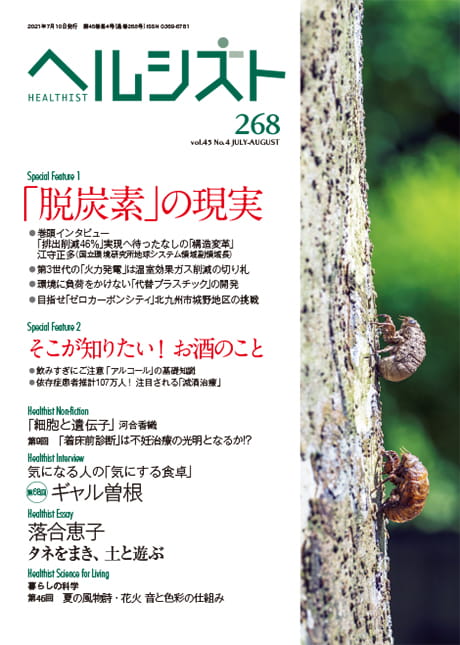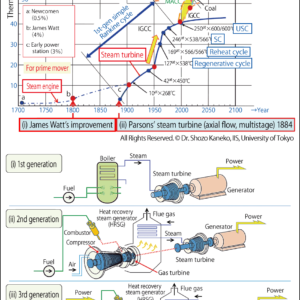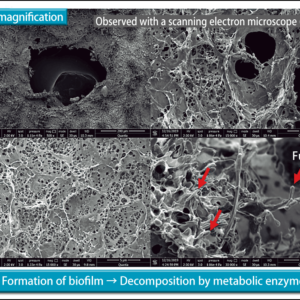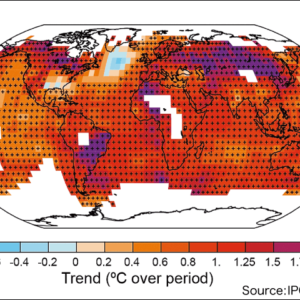Reducing CO2 emissions will require that we change our way of life and community-wide initiatives will be essential to achieve this. The City of Kitakyushu was one of the earliest municipalities to espouse the FutureCity Initiative and, in October 2020, declared itself a Zero Carbon City, vowing to achieve net-zero greenhouse gas emissions by 2050. Various initiatives are being undertaken in communities throughout the city. However, establishing ways of life that contribute to achieving the zero-carbon goal seems likely to take some time.
Special Feature 1 – The Zero Carbon Reality Field report Aiming to become a zero-carbon city: Kitakyushu’s Jono district takes up the challenge
composition by Rie Iizuka
illustration by Koji Kominato
Inspired by its experience of having overcome the serious harm caused by industrial pollution in the 1960s, the City of Kitakyushu has consistently undertaken environmental protection initiatives. As the 1990s approached, the city embarked on its Eco-Town Project with the objective of building a zero-emission society based on resource recycling, aspiring ultimately to reduce waste to zero through the reuse of waste. In 2004, the citizens, businesses, and government of Kitakyushu came together to formulate a grand design aimed at turning the city into the environmental capital of the world. Kitakyushu also actively engages in international cooperation projects, such as those focused on sharing with developing countries the environmental conservation technologies cultivated in the city in the process of overcoming industrial pollution. These efforts have been met with high acclaim from around the world; Kitakyushu received the Global 500 Award from the United Nations Environment Programme (UNEP) in 1990 and the United Nations (UN) Local Government Honours Award in 1992.
Measures to combat climate change and the creation of a zero-carbon society are the logical extension of these urban development projects with an environmental theme. Kitakyushu is also proactive in tackling the issue of global warming. After being accredited by the Japanese government as an Eco-Model City in 2008, it was selected by the Organisation for Economic Co-operation and Development (OECD) in 2011 to be the subject of a case study as part of the Green Growth in Cities Programme, joining Paris, Chicago, and Stockholm as one of four model cities worldwide based on its success in achieving green growth (development that achieves compatibility between environmental protection and economic growth).
Early on, Kitakyushu set a target of reducing CO2 emissions from the FY2005 level by 50% within the city and by 150% in total across the whole of Asia. As part of efforts to achieve this goal, the municipality established the Kitakyushu Asian Center for Low Carbon Society to serve as a nucleus for pursuing the revitalization of the regional economy by promoting the transition to lower-carbon societies in Asia. Then, in 2020, Kitakyushu responded to the national government’s policy by declaring itself a Zero Carbon City, vowing to create a zero-carbon society by 2050.
One of the major projects being implemented in this regard is the redevelopment of the Jono district (approximately 19 ha), one minute from JR Jono Station. Urban development aimed at a zero-carbon future is progressing through such efforts as the construction of eco-houses, the installation of energy creation and conservation equipment, and the optimization of energy use via energy management. As of January 2021, the district was home to 606 private dwellings, 13 corporations, and approximately 1,300 citizens.
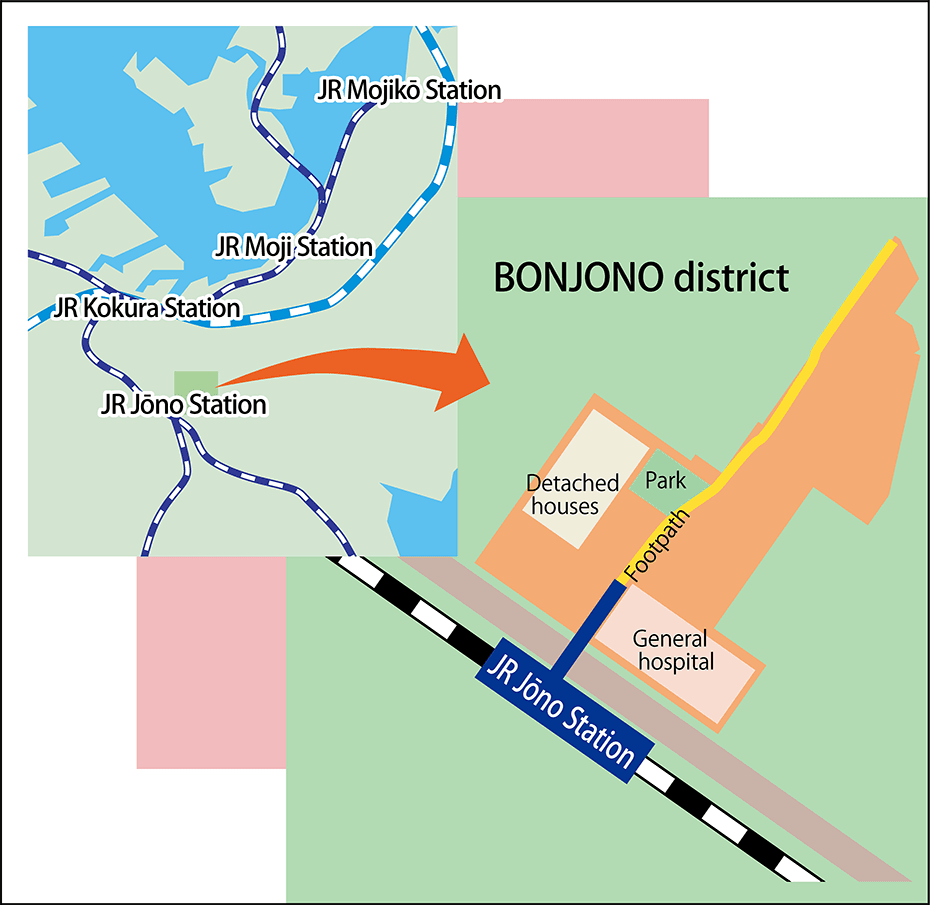
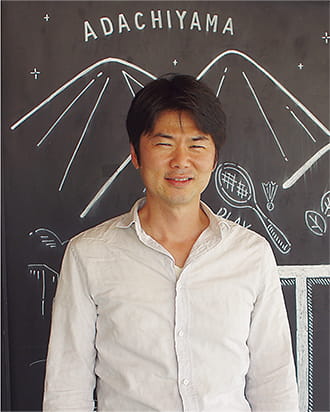
Aiming for a 100% reduction in CO2 emissions from detached houses
The first thing to meet your eye when you exit Jono Station and stand on the pedestrian deck is Kitakyushu General Hospital. Numerous solar panels have been installed on its south-facing roof.
We asked local resident Professor Yoshiaki Ushifusa of the University of Kitakyushu’s Faculty of Economics and Business Administration to show us around the area. He gave us a brief overview of the district.
“Under the name ‘BONJONO: District of the Future for Everyone,’ the Jono district is undergoing sustainable urban development aimed at reducing CO2 emissions, while at the same time ensuring that diverse generations will be able to continue living here in the long term,” he says.
“As this is a zero-carbon neighborhood, the detached houses are designed to be well-insulated and airtight for energy efficiency, with solar panels fitted as standard. The multi-unit condominiums, too, are low-carbon, equipped with solar panels, albeit on a small scale, and Ene-Farm (home-use fuel-cell cogeneration system) in each unit. In addition, a home energy management system (HEMS) has been installed in each home, so that residents can ascertain at all times the amount of power being generated by sunlight or Ene-Farm, along with the amount of energy being consumed. Through these initiatives, the city aims to reduce CO2 emissions from detached houses by 100% and from condominiums by 70%.”
Local housing company Toho Home K.K. has opened a show house in the district where people can stay overnight to experience an eco-home for themselves. While the specifications of the houses differ slightly according to the developer, we will introduce one example here.
The company uses the exterior insulation method for many of its houses. This involves enclosing the roof, walls, and foundations of the entire house with insulation, ensuring greater airtightness so that the house is less affected by the outdoor temperature all year round. In addition, their Hybrid Air Control System promotes the circulation of air throughout the house by systematically taking in air from outside via an intake vent and circulating it through each floor of the house, while simultaneously using geothermal energy —— which demonstrates less variation in temperature throughout the year —— to keep the rooms cool in summer and warm in winter.
The future introduction of a community energy management system (CEMS) to the Jono district, to balance power demand and supply to meet the community’s electricity needs is also being looked at (Figure 1).
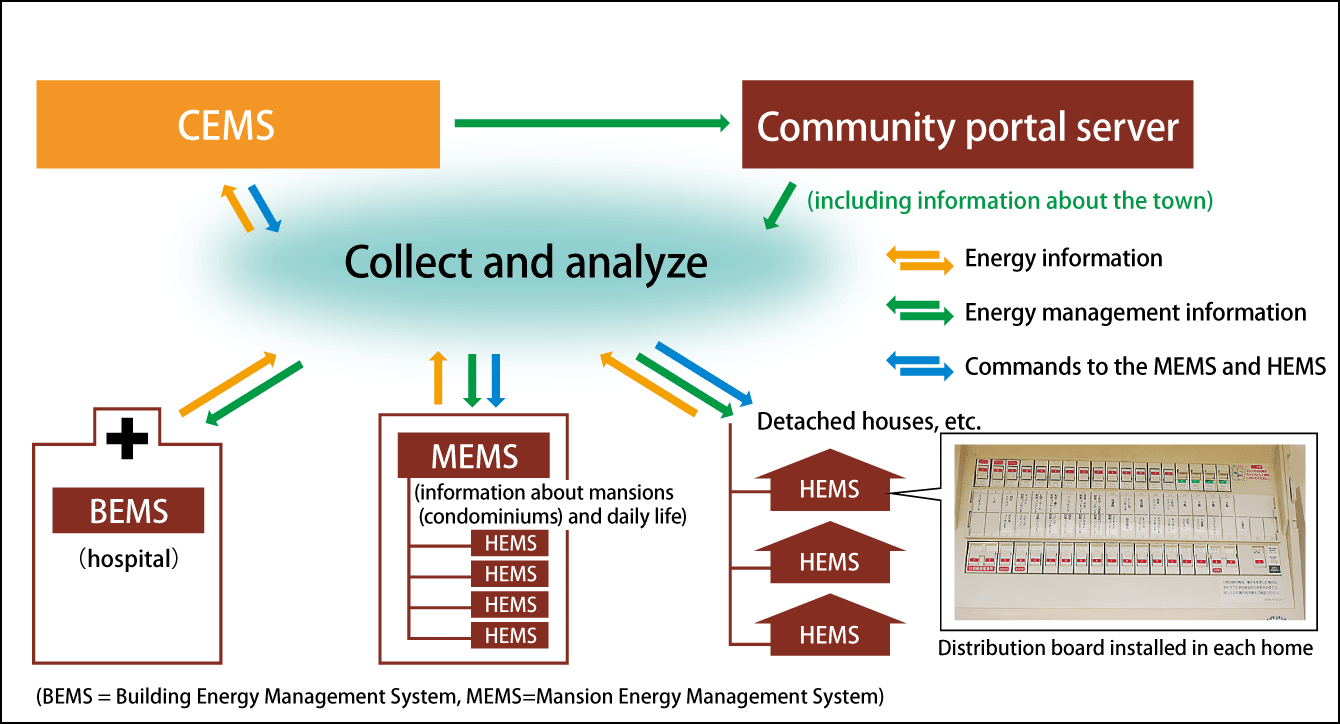
Figure 1. CEMS concept diagramOptimizes energy use by collecting and analyzing information about energy use and electricity generation by local facilities and stores.
Devices showing the status of the HEMS are installed as standard in each home (Figure 2). Connected to the solar photovoltaic power generation system and indoor electrical equipment such as air conditioners, water heaters, and lights, these devices show residents their energy usage, enabling them to automatically control the energy used by each item of equipment and to conserve electricity in a comfortable way. These systems are essential to efforts to achieve a zero-carbon society.
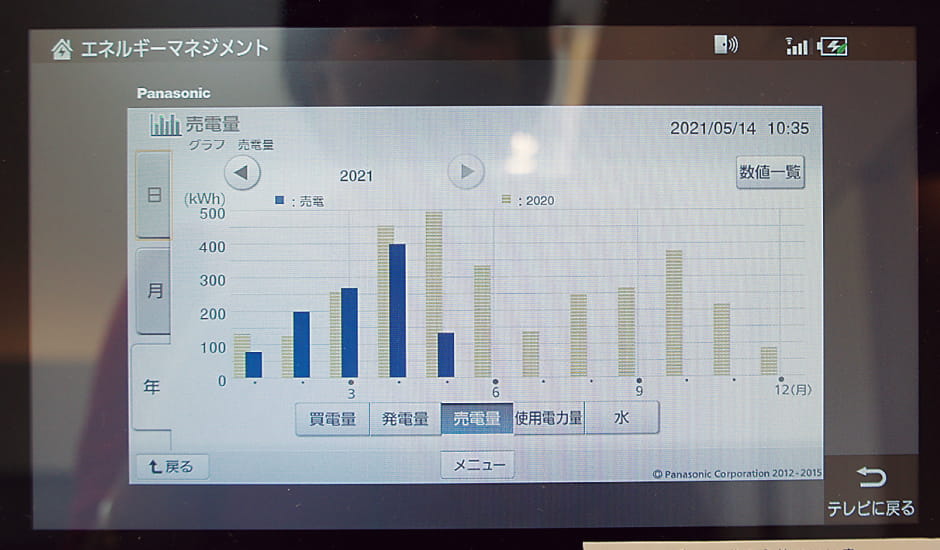
Figure 2. Device showing the status of the HEMSRenders energy usage visible.
The condominiums constructed by the company in the district are the only ones in the City of Kitakyushu to have been accredited as low-carbon housing. Each unit is equipped with Ene-Farm that uses the hydrogen in gas to generate electricity, while also using the warm water produced in this process to heat the household’s water. All interior windows are fitted with Low-E glass (glass whose surface has been coated with a special metallic film called a low-emissivity film, which reduces temperature fluctuations by absorbing and reflecting heat from solar radiation and indoor heating systems), ensuring enhanced insulation performance. Lighting in communal areas is partly powered by solar photovoltaic power generation. As a result, the units in the condominium are capable of cutting primary energy (energy from fossil fuels such as oil and coal, and from the nuclear fuel uranium) consumption by a further 10% from the energy conservation standards set by the Ministry of Land, Infrastructure, Transport and Tourism.
The zero-carbon goal cannot be achieved via equipment alone
Houses built in Bonjono by this company and others are equipped as far as possible with facilities that will help to achieve the zero-carbon goal, while also taking into account the burden on individual households.
The community is not solely focused on the zero-carbon future; to maintain a high-quality living environment with a diverse range of generations, it is furnished with a Wi-Fi-enabled study room open to all local citizens, which children can use as place for self-study. In addition, a housing development offering living support services for seniors was opened in 2020.
Not only the houses, but also the district itself has a tranquil, open atmosphere. “Replacing fences with trees and shrubs has created a verdant neighborhood, while also contributing to the absorption of CO2,” Ushifusa says.
In some blocks composed of detached houses, the specifications state that each house should have two or more medium-to-large trees standing at least 2.5 m tall, while in the case of condominiums, two or more medium-to-large trees standing at least 2.5 m tall must be planted per 165 m2 of site area once the building area has been deducted. In some blocks, utility poles have been removed and power lines buried underground, making the streets feel more spacious.
Heat insulation paving has been laid on road surfaces in the district to reflect infrared, curbing heat absorption and reducing the tendency of both the road surface and the surrounding air to warm up. When we visited the Jono district, the temperature was 26.5°C and surfaces not equipped with this paving felt very hot to the touch. Roads with heat insulation paving, on the other hand, did not feel at all hot and the difference between the two was stark.
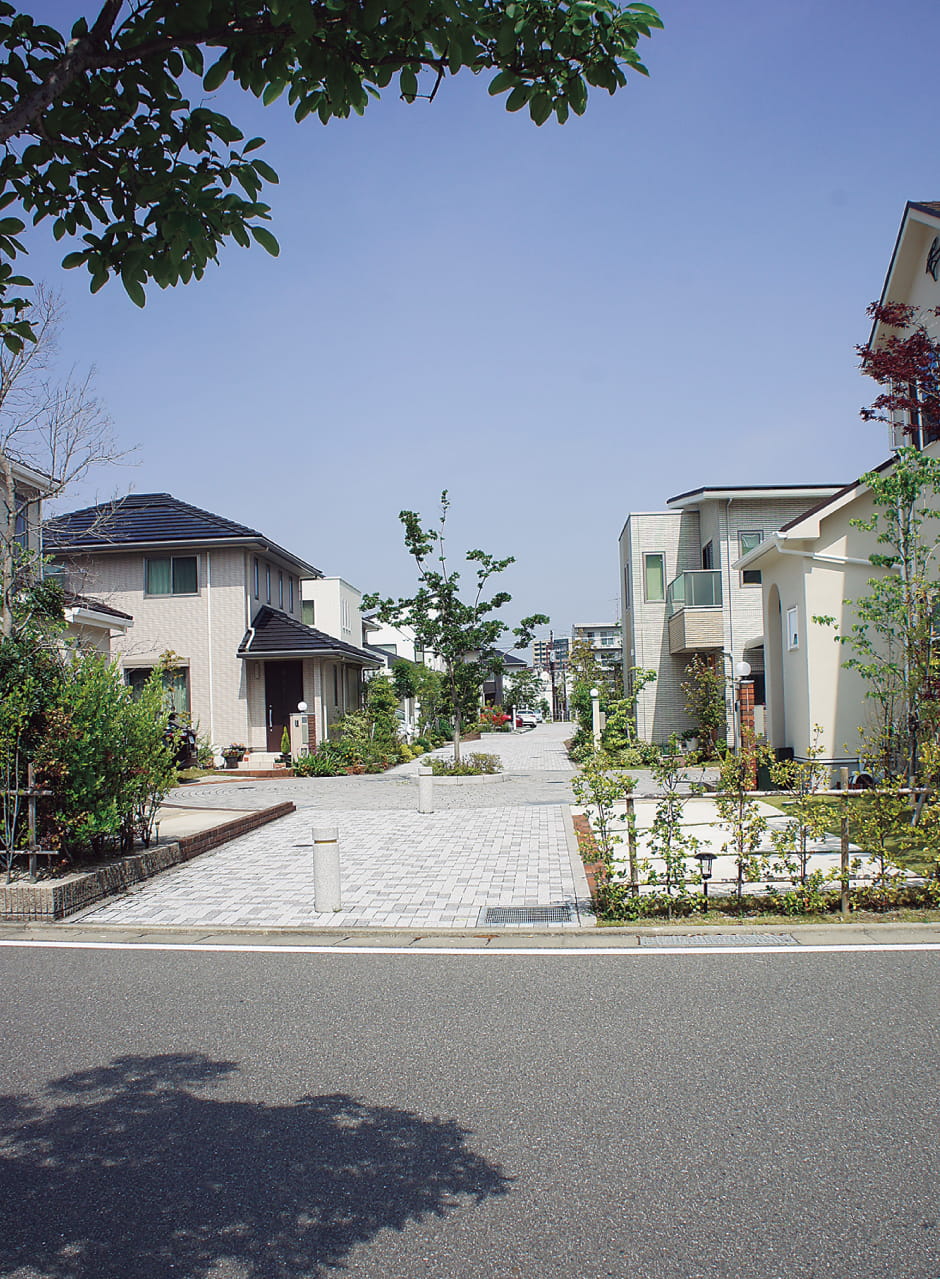
Creating comfortable living environments also leads to the creation of a Zero Carbon City.
Installing equipment will not be enough to achieve the zero-carbon goal. As described above, one condition of development is that the houses in the Jono district must have solar panels installed. It would be fair to describe this as a groundbreaking initiative, in a sense. This is because installing solar panels results in a commensurate increase in construction costs, which is reflected in the price of these houses. So, are the people who want to live in this area nonetheless local citizens with an understanding of such advanced initiatives?
“The area is popular, because it’s close to Kokura in central Kitakyushu and offers a good living environment, so I think people accept that prices are somewhat higher,” Ushifusa says. “But to be quite honest, I don’t know how many citizens decided to buy a home here because they supported the zero-carbon concept.”
The HEMS provides each household with a detailed picture of its energy consumption, including the amount of power generated at the house and the current level of energy use. Ushifusa says that it is interesting at first, as residents can see how the amount of power generated differs between sunny and cloudy days, and also how electricity usage changes when they take care to turn the electricity off or modify the way they use the bath or make other lifestyle changes.
However, “Unfortunately, although we often checked the system when we first moved in, because of the novelty value, we’ve gradually stopped taking any notice of it as we’ve become accustomed to it,” he admits.
CO2 emissions failing to fall as expected
Looking at the extent to which households using both electricity and gas achieved the zero-carbon goal between April 2019 and March 2020, we can see that CO2 emissions have not fallen to the extent expected (Table).
| (i) CO2 reduction from energy creation | (ii) CO2 emissions from energy use | (i)-(ii) | |||
|---|---|---|---|---|---|
| Solar Power | Ene-Farm | Purchased Power | Gas Consumption | Actual CO2 Reduction | |
| April 2019 | 164.48 | 78.11 | 91.61 | 278.46 | -127.48 |
| May 2019 | 194.32 | 48.16 | 52.74 | 234.26 | -44.52 |
| June 2019 | 175.24 | 45.84 | 23.60 | 170.17 | 27.31 |
| July 2019 | 149.21 | 41.74 | 33.66 | 137.02 | 20.28 |
| August 2019 | 112.43 | 28.07 | 54.13 | 90.61 | -4.24 |
| September 2019 | 98.90 | 34.91 | 74.95 | 110.50 | -51.65 |
| October 2019 | 108.26 | 46.60 | 46.15 | 170.17 | -61.45 |
| November 2019 | 120.06 | 73.36 | 48.58 | 223.21 | -78.37 |
| December 2019 | 57.95 | 107.78 | 99.94 | 262.99 | -197.20 |
| January 2020 | 52.40 | 117.84 | 156.50 | 395.59 | -381.85 |
| February 2020 | 36.09 | 108.09 | 161.01 | 346.97 | -363.80 |
| March 2020 | 78.77 | 116.14 | 127.70 | 353.60 | -286.39 |
| Total | 1348.10 | 846.65 | 970.56 | 2773.55 | -1549.37 |
Table. Achievement of the zero-carbon goal in households using both electricity and gasWhile CO2 emissions have been reduced, there are still quite a few challenges remaining before the goal can be achieved.
(Courtesy of Yoshiaki Ushifusa)
“There appear to be some challenges here,” Ushifusa says. “I plan to conduct a detailed analysis of the HEMS data in due course, but just from a quick look at the figures for 2019, it seems that local citizens might be failing to pay attention to the way in which they use energy precisely because they have their own electricity generation facilities. At the same time, I think the residents of Jono district have more opportunities to come into contact with the zero-carbon concept than those living in other districts, but perhaps this alone is not sufficient to encourage proactive efforts.”
“One way of modifying local citizens’ behavior might be to appeal to them from a different viewpoint, for example, by providing zero-carbon meals at the local kodomo shokudō (kids’ cafeteria),” Ushifusa suggests.
To achieve the zero-carbon goal by such means as using CEMS to promote self-sufficiency in electricity, it seems it will be necessary to combine efforts to cultivate awareness of the purpose through the visualization of electricity use and clarification of its significance with demonstration of the specific advantages, such as reduced costs.




